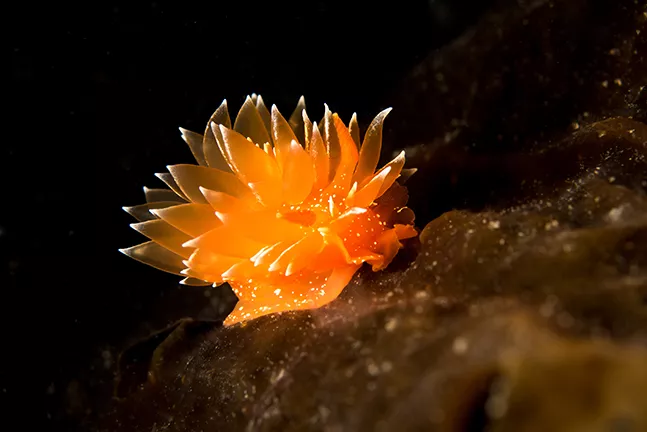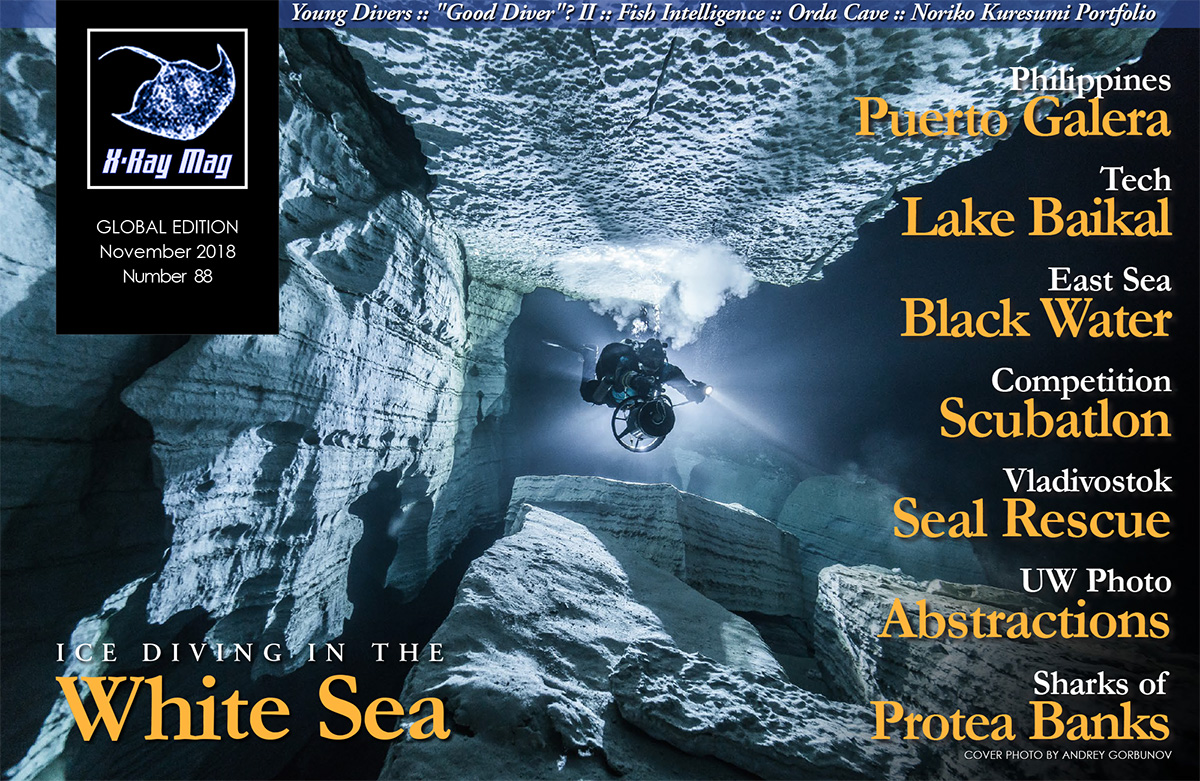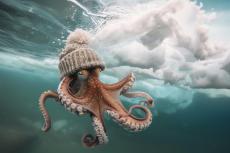Many want to feel what it is like to fly in the cosmos—how one’s body levitates in dark space. Personally, I have never been in space, but I have found this feeling on night dives.
Contributed by
Factfile
Aleksei Kondratuk is an underwater photographer and naturalist born and raised in Vladivostok, on the shores of the East Sea, in the Russian Far East.
After specializing in economics and mathematics, he became a divemaster and began photographing the underwater world.
For more information, visit: uwvision.com.
Some people say that open water is an extreme environment, so what would be a good reason to enter it at night? I say that night dives allow divers not only to feel like cosmonauts, but they can also explore a different underwater world. There are thousands of creatures in the ocean that hide during the day and are active at night. So, when the darkness comes, the show begins.
In the Russian Far East, I have spent a lot of time in dark water with my camera, searching for new inhabitants in my native East Sea. The more I found, the more I wanted to find more. Each night dive became, for me, a kind of little expedition. Each time, I found something new. It could be a creature that I had not seen before, or a relationship between creatures that showed a different side to them.
Critters of the dark
So, what kind of creatures can we see in black water? First, there are the night hunters like crustaceans, fishes and cephalopods. As an underwater naturalist, I have my own wish list—a list of all the animals that I want to capture with my camera.
Mantis shrimp. For two years, the Oratosquilla oratoria was a "wanted" critter on my wish list. What a surprise it was when I found it on a night dive at a depth of five meters in the house reef of my dive center.
This shrimp is a kind of "universal soldier." These unusual crustaceans lead a secretive life, and hide in deep burrows. In addition, they have the most perfect vision on the planet. Their faceted eyes are able to distinguish not only polarized light, but they can also see things in the infrared and ultraviolet spectrum. Therefore, the slightest movement of a diver does not go unnoticed by them.
In addition to their excellent vision, nature also awarded them with a powerful weapon: claws. A mantis shrimp can break the large shells of bivalve mollusks without much difficulty. After all, the shot of its claw is similar to a shot from a 22-caliber pistol. These weapons of the mantis shrimp work like a spring; muscle contractions accumulate huge energy in the curved saddle-shaped grooves of its claw. Then the shrimp clicks the claw underneath itself. Similar to the principle of the crossbow in which the bowstring is stretched and snapped into the trigger, and then, when pressed, is released, producing a shot, so does the mantis shrimp strike its prey as it releases the latch and its claw shoots out at a speed of 80km/h (~50mph), with the impact force reaching 150kg (330lbs). Believe me, this is very tangible; I managed to test its strike on my finger.
Plankton and jellies. Diving in black water is a great opportunity for shooting tiny plankton species and jellyfish. This is because the light of one’s torch is reflected off their bodies. Such reflections help me to find new species of jellyfish for my photo collection. Almost all of them are transparent and small in size—about 4mm. In the cold waters of March (around -1°C or 30°F), I found a hydromedusae jellyfish, Bougainvillia superscillaris. At the same time, I found another tiny creature—the sea spider, Nymphon grossipes. And during the next night dive, I captured the relationship between these two species. Sea spiders swim up from the muddy sea bottom, catching jellyfishes and eating their eggs. Watching this happen was a really fantastic event!
Planning your night dives
Equipment. First, pay attention to your equipment. You should bring at least two fully charged underwater torches with you. I recommend you use torches with a wide beam, so you won’t miss anything!
Dive site. Choose dive sites that you know well. Believe me, they will be different at night. But in case you get lost, you will be able to find your way back, since you are already oriented with the site.
Communication. Discuss hand signals with your buddy on shore before the dive; it will make your underwater conversation easier. Remember that both of you will be in the dark, so try to explain yourself with only one hand, because your other hand will be holding your camera flash. If you choose a shallow dive site, you can go up at any time to find the light of your buddy's torch at the surface. But if you choose a deep dive site, try turning off your torch to find the light of your buddy’s torch, in case you lose sight of him or her.
Time of day. The best time to get in the water is at sunset. There is still enough light at the surface to check your equipment, but the water is already dark by that time.
Stay calm. Another thing: You should keep calm and forget your fears during night dives. If you let it, your imagination can conjure up all kinds of horrific thoughts when you see something strange underwater. I remember on one scary dive, a big green worm appeared in front of the mask of my buddy, and in the next moment, we saw a buoy covered with algae—it looked like a dead man. Remember the golden rule of every diver: "STOP. THINK. ACT."
Shooting tips
Macro. Shooting macro in black water is a good experience for underwater photographers. It is rather difficult to catch a small creature in the frame. Camera lenses will try to focus on the tiny creature and move forward and backward all the time. Use a focus light. Look at the viewfinder and move the camera towards the object. When it comes into focus, push the shutter. If this does not help, do the same thing again, but click the shutter with the auto exposure lock (AEL) button.
Strobes. If you use a TTL converter with powerful torches at night, your pictures will be underexposed. The camera sensor will see the picture in good light conditions and will send a low-light impulse to the strobes. In this case, it is better to use your strobes in manual mode.
Wide-angle. Shooting wide-angle in black water is a good experience too—especially when you find an interesting animal like a giant octopus. On one occasion, my buddy and I did a rather deep night dive. It was about 110ft deep. At that depth, we found a huge and very friendly giant octopus. It came out of the rocks, trying to identify what sort of bubble-making creatures we were. The session with the octopus was marvelous.
Lighting angles. Sometimes I place my strobes behind the subject. This adds creativity to a picture, especially when the subject is transparent, such as big jellyfish or comb jellys.
Try to use your imagination. Don't be afraid to use different photography techniques. All that you need is practice and a bit of luck. ■
























































